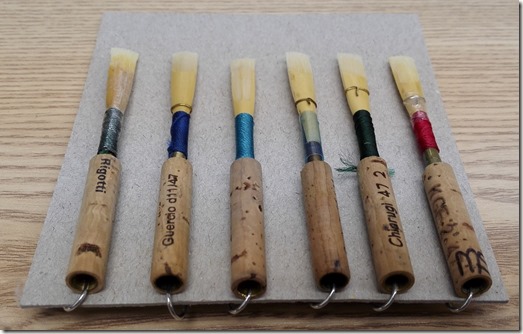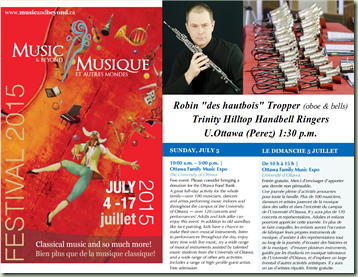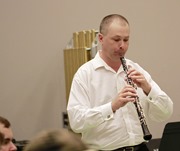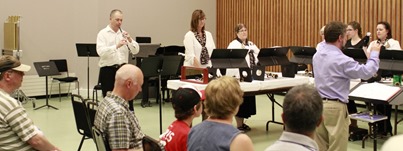| CAUTION: These are my own impressions on very small sample of reeds. Evaluating a reed for any other person is a terribly delicate issue, even when people play together frequently. To evaluate reeds for people we have never even met, possibly inhabiting distant countries with vastly different climates and geographic considerations is almost ridiculous. Any reed instrument player with any reasonable amount of experience will agree that, from any same reed producer, a dozen reeds can play very differently. I have tried only one reed from each maker, so my opinions cannot be considered representative of their work. | Je m'efforce au bilinguisme, chers lecteurs francophones, parce que vos visites me font franchement honneur! Mais cet article est assez long et la grande majorité des mes visiteurs comprennent l'anglais, pas le français – alors puisque je ne reçois aucune rémunération ni faveur quoi que ce soit pour ce blogue, je réserve le droit de préserver un peu de mon temps libre pour mes autres loisirs… Merci de votre compréhension! |
Why then even write this post? Well for one, I promised Vicky I would... which is fine because I actually do like the reeds she sent. Also, it might be interesting for the reedmakers to get a distant opinion. But mostly, I hope this will encourage oboists when reeds don't always meet their needs – and possibly provide and idea of what to expect when making or buying oboe reeds as well as some insight on what mind-frame to adopt when evaluating them.
General Observations
When Vicky offered to send me reeds to try, she asked me what strength I prefer. I really had no clue, so I just answered something and she sent me one reed from each maker. This means that I could have made serious mistakes in my choices with no way of knowing!
Each reedmaker produces reeds of different strengths and styles for different levels of experience and/or physical ability. This is where experience and the ability to order different samples from the same place comes-in handy. And no matter how careful a person may be in selecting cane, it remains the product of a living plant, not an engineered polymer! Arundo donax (a variety of grass!) is a living organism that will always behave in unexpected ways. So, having just one reed from each maker is really not a good representation of their work. Also for this reason, I prefer not to describe scraping profiles or measurements.
What is a "professional reed"?
I have very happily corresponded with a number of reed makers via the internet. Some makers consider “professional category” reeds simply to be more resistant reeds (harder, but still ready to play right out of the box) whereas other makers understand that many professional level players will want to fine-tune reeds to their own tastes. In the case of American scrape, I think the ability to adjust them is even more important, because individual styles are so much more sensitive and impactful.
All the reeds Vicky sent me are professional grade, except the Tipple which is medium-soft, designed for high-school students. The hard reeds are too much for me to play on for more than a few minutes at a time. BUT despite this, they are among the most responsive reeds I have ever played on! Strangely, it takes lots of air pressure (perhaps because of the climate/geographic change) but responsiveness is so easy it’s almost scary! I have never worked much at developing double-tonguing, but despite the hardness, these reeds help me do double-tonguing more easily and clearly than my own reeds. They also all appear to prefer an embouchure that does not change.
I got the reeds in late April, so I have been playing them once-in-awhile from early spring to mid-summer. The change in the weather has drastically changed the reeds behaviours: some have completely exchanged characteristics to the point where I have to look at the thread color and my notes to remember which is which! This supports my assumptions that:
All reeds are excellently bound/tied: no sideway slipping of the blades at all – I really appreciate that! I find reeds that slip (overlap sideways) have a warmer, more velvety sound with perfect stability, but they also make me feel very choked when playing and I tend to get dizzy spells with them. However, a number of professionals from different countries told me they prefer reeds WITH a slipped overlap, so it's a matter of personal preference.
One recommendation I would make to all reed makers using wire: don't ship them without some kind of cellophane to cover the wire! Not only does it prevent the lips and/or fingers from bleeding by accidental yank, it also keeps the wire in place. No matter how well you tie the wire, it is in the middle of a curve and will drop really easily, thus messing-up all your fine-adjustments! Back in the 1980's, "gold beater's skin" (the natural membrane used to wrap sausages) was popular and despite its delicateness, it worked rather well. Plumber's tape and food wrap can do well, but they tend to unwrap when wet or strangle the reed. My favourite modern cellophane is "Parafilm M" laboratory tape: it stretches and clings firm and resists friction as well as soaking – revolutionary, in my opinion.
From left to right:
Qing Lin, Kai Rapsch, Laura Arganbright, Koje, Tamo Ramirez, Tipple
Recordings:
I did make recordings to compare the reeds. I have a new microphone, and when I combine it with my old one, I get a very good sound, almost true-to-life. But when I play back the recordings of the reeds, the difference in sound is so small they almost sound the same. I used 4 different head-sets and 3 different loud-speaker setups: each setup sounds different overall, but on the same setup the reeds only show minute differences in tone colour. This is unfortunate because when playing them in person, they really do sound different. I think the lessons here are:
Observations on each maker:
Qing Lin (China/Germany):
a new professional, already distinguished in performance. I had the real pleasure of hearing him play one of the Lebrun concerti: the prize for winning the Gillet-Fox competition at IDRS 2013. Harder than the others and also more fluffy on articulations, these reeds provide a very beautifully haunting sound.
One thing I always wanted to try (but never did) is something he does on all his reeds: where books say to cut the corners (making the tip narrower) he leaves the "ears" on from the shaper! Again, understanding that the change in geography and climate can exaggerate the strength of the reed, this reed testifies to his current stay in Germany with an absolutely stable reed built for solid professionals who want the plushest sound.... I have to wonder if this might be in the lineage of the legendary sound of Lothar Koch...
Koje (Malaysia):
Laura Arganbright (USA):
American scrape has never been in my favour, so I don’t want to risk misrepresenting her reeds. But, I hear many, many American oboists sound very crystalline or metallic despite the reputation of that scrape: Laura’s reeds are among the warmest, darkest, silky sounding reeds I’ve played from any style at all. Her philosophy, concerning professional reeds (and I do agree with it) is that professionals will want personal fine-tuning, so she does leave room for finishing touches.
Her scraping is clearly very well controlled, clean and I am very impressed with how perfectly the blades are aligned (two aspects not always characteristic of American Scrape). Actually, her scrape is so clearly meticulous it almost looks like a component for the Mars Rover! In line with her philosophy on pro-reeds, I think it is a fantastic starting point for any professional who wants to save time and effort and fine-tailor the reed to their own stylistic preferences: the scrape leaves room for any variant of American scrape I have ever seen.
Cayetano “Tamo” Ramirez (Spain):
his is probably the closest to how I make reeds. I don't mean what the scrape looks like, but rather how the reed behaves with respect to articulation and air pressure. The sound is also very warm, but more clearly defined in a reed that really does want to play along with my whims. It is also the reed that plays most easily in the altissimo range (especially above F). This is where I really believe the geographic/climate conditions are making all these reeds harder than they are really supposed to be: Ramirez reeds play so much like how I design mine, that I find it hard to believe they are truly this hard. What he told me is that, in Spain, they do like reeds a little bit harder compared to many other parts of the world, but not as hard as the Germans like them.
Kai Rapsch (Germany):
Despite being hard, I really like it! It will be a source of study for me. Like the Ramirez reed, it behaves the way I like reeds to behave, but with a heavier sound: possibly designed for an instrument that demands more support from the player, it also tends to play 2nd octave key notes flat (compared to the others) on my Lorée. From my experiments trying instruments, this reed would be great with a Marigaux M2 or a Mönnig 150 where I have found the 2nd octave notes sharp (according to professionals I have chatted with, sharpness/flatness seems to vary with geographic location).
The tip is the shortest I’ve ever seen in my life! But this takes nothing at all away from its responsiveness: I can articulate notes the way I like to, period! Like my own reeds, his reeds sound very clearly defined, but unlike my reeds, there is not a hint of crystal or buzz: sheer oboe warmth.... it makes my Lorée sound like a Ludwig Frank!
Tipple (UK):
mission accomplished! He wants his reeds to play just fine “right out of the box”, and I concur this to be true! Perhaps Suffolk, England has similar climate to Ottawa? Whereas the reeds I have from other makers are professional grade, the one I have from Tipple is a medium-soft (high-school) reed: so I must hold back my power. The scrape is short but the cane shape is narrow (like American reeds): this helps maintain precision and quality of tone-colour for people with less air power, likely very suitable to many adult amateurs. This reed is very well designed to promote good embouchure and breathing habits in students: biting on this reed will kill the tone whereas a relaxed embouchure will allow any articulation you want. Being narrower, it would likely be a great starting point for habituates of American reeds who want to explore European scrape.
Conclusion:
I personally, will not start buying reeds. I have been making them for 30 years: as a hobbyist, making reeds is part of the excitement of this oboe journey. With my engineer's attitude, even if I played saxophone I would probably make my reeds and even mouthpieces! However, this experience has been very enlightening about the possibilities for reeds and the usefulness of buying some (from time to time and from very different makers) as a source of study.
![]() I think for professionals who want to save time (devote more time to practice and family in a busy performance schedule) buying reeds from Vicky (her website here) and/or other well reputed venues is an excellent idea: the professional can then spend only a few minutes fine-tuning them as needed without worry. I am very curious to try the reeds Koje plays on himself: apparently much easier to blow. For someone like myself, who likes to explore and experiment, these reeds are a fantastic source of investigation using the Ramirez and Rapsch reeds: I will be doing lots of comparisons and experiments on my own reeds.
I think for professionals who want to save time (devote more time to practice and family in a busy performance schedule) buying reeds from Vicky (her website here) and/or other well reputed venues is an excellent idea: the professional can then spend only a few minutes fine-tuning them as needed without worry. I am very curious to try the reeds Koje plays on himself: apparently much easier to blow. For someone like myself, who likes to explore and experiment, these reeds are a fantastic source of investigation using the Ramirez and Rapsch reeds: I will be doing lots of comparisons and experiments on my own reeds.
I think students and amateurs, who have teachers who really answer the student's goals, getting these specific reeds would be an excellent start as the teacher can fix the reeds to suit the student perfectly. Also, these reeds are excellent to show students what to aim for, and acquire the skills to fine-tune a reed that is already quite good.
For students and amateurs who need a reed to be ready for concert right out of the box, Tipple should be quite good, and I really suspect that getting a softer Koje or Ramirez would be advisable. Qing Lin and Kai Rapsch (also the "Michaela" by Koje) should be considered for more advanced students who want to develop specific sound qualities.
Do Contact Vicky (and your local reed maker) with questions – I know she is continually trying other makers and sources to provide the best possible product for her clients.










